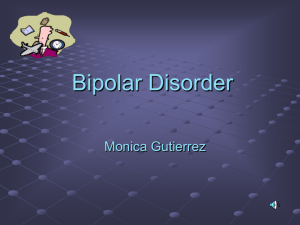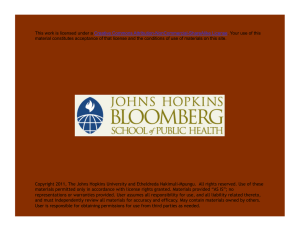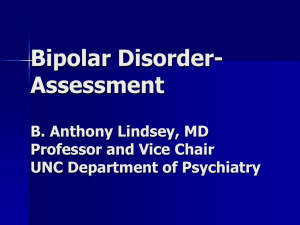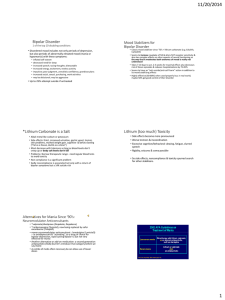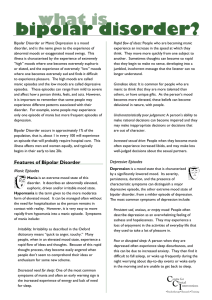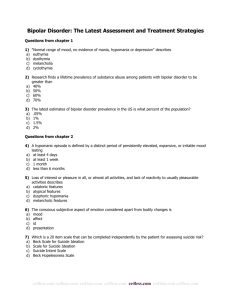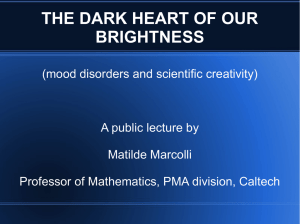BIPOLAR AND RELATED DISORDERS-2.docx
advertisement
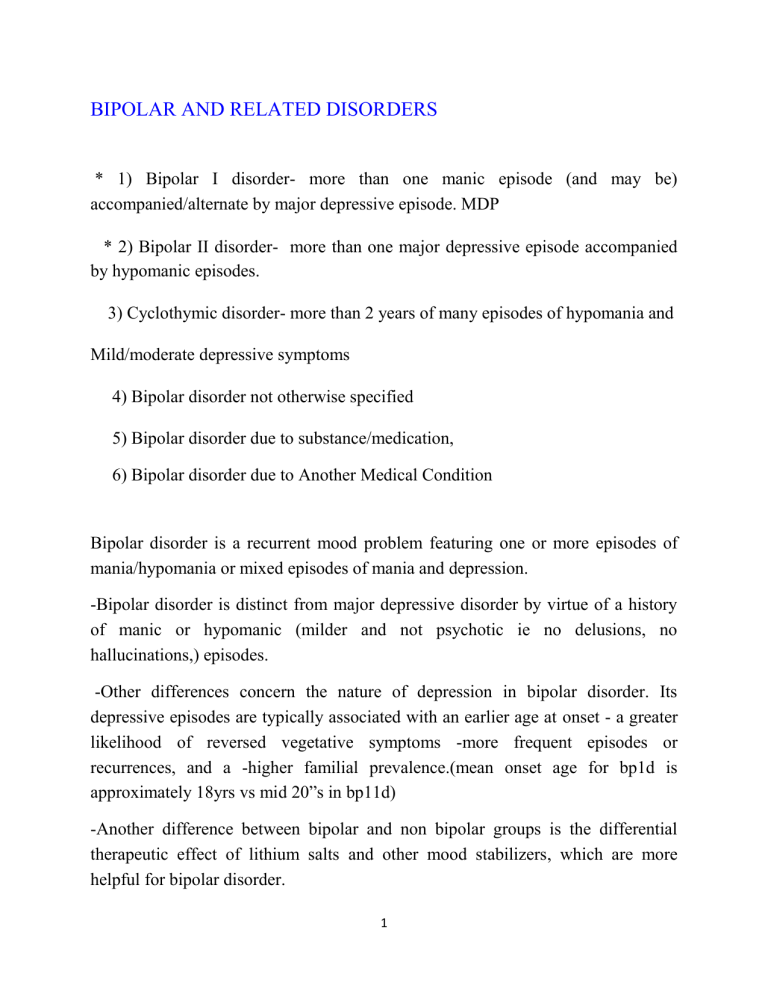
BIPOLAR AND RELATED DISORDERS * 1) Bipolar I disorder- more than one manic episode (and may be) accompanied/alternate by major depressive episode. MDP * 2) Bipolar II disorder- more than one major depressive episode accompanied by hypomanic episodes. 3) Cyclothymic disorder- more than 2 years of many episodes of hypomania and Mild/moderate depressive symptoms 4) Bipolar disorder not otherwise specified 5) Bipolar disorder due to substance/medication, 6) Bipolar disorder due to Another Medical Condition Bipolar disorder is a recurrent mood problem featuring one or more episodes of mania/hypomania or mixed episodes of mania and depression. -Bipolar disorder is distinct from major depressive disorder by virtue of a history of manic or hypomanic (milder and not psychotic ie no delusions, no hallucinations,) episodes. -Other differences concern the nature of depression in bipolar disorder. Its depressive episodes are typically associated with an earlier age at onset - a greater likelihood of reversed vegetative symptoms -more frequent episodes or recurrences, and a -higher familial prevalence.(mean onset age for bp1d is approximately 18yrs vs mid 20”s in bp11d) -Another difference between bipolar and non bipolar groups is the differential therapeutic effect of lithium salts and other mood stabilizers, which are more helpful for bipolar disorder. 1 Between 25-50% of patients in developed countries with bipolar disorders are estimated to attempt suicide with almost 15% of them succeeding/complete act. *A bridge between depressive disorders and scz spectrum + other psychotic disorders? Mania is derived from a French word that literally means crazed or frenzied. The mood disturbance can range from pure euphoria or elation to irritability to a labile admixture that also includes dysphoria. -Thought content is usually grandiose but also can be paranoid. Grandiosity usually takes the form both of overvalued ideas (e.g.,) and of frank delusions. -Auditory and visual hallucinations complicate more severe episodes. -Speed of thought increases, and ideas typically race through the manic person’s consciousness. Nevertheless, distractibility and poor concentration commonly impair implementation. -Judgment also can be severely compromised; spending sprees, offensive or disinhibited behavior, and promiscuity or other objectively reckless behaviors are commonplace. -Subjective energy, libido, and activity typically increase but a perceived reduced need for sleep can sap physical reserves. Sleep deprivation also can exacerbate cognitive difficulties About 0.6 percent of the adult population suffers from the type I form, and 0.3 percent from the type II form. Episodes of mania occur, on average, every 2 to 4 years, although accelerated mood cycles can occur annually or even more frequently. - The type I form of bipolar disorder is about equally common in men and women, unlike major depressive disorder, which is more common in women. >90% of people with a single manic episode go on to have recurrent mood episodes 2 Hypomania- By definition, an episode of hypomania is never psychotic nor are hypomanic episodes associated with marked impairments in judgment or performance. some people with bipolar disorder long for the productive energy and heightened creativity of the hypomanic phase. -Hypomania can be a transitional state (i.e., early in an episode of mania), although at least 50 percent of those who have hypomanic episodes never become manic. -Whereas a majority have a history of major depressive episodes (bipolar type II disorder), others become hypomanic only during antidepressant treatment. -Despite the relatively mild nature of hypomania, the prognosis for patients with bipolar type II disorder is poorer than that for recurrent (unipolar) major depression. -Women with bipolar disorder are also at increased risk for an episode during pregnancy and the months following childbirth. **Etiology- BPS **NT- da, na, 5ht, gaba, glutamate ** genetics very strong attachment/psychosocial bp11d>bp1d>mdd ** class B personalities, ** prev high y> low y countries?, singles>married ** stress both negative and positive DSM-IV TR/V criteria for manic episode A. A distinct period of abnormally and persistently elevated, expansive, or irritable mood and persistent increase in goal directed activity or energy lasting at least 1 week (or any duration if hospitalization is necessary). A. During the period of mood disturbance, three (or more) of the following symptoms have persisted and have been present to a significant degree, represent a noticeable change from usual behavior: 1. inflated self-esteem or grandiosity 2. decreased need for sleep (e.g., feels rested after only 3 hours of sleep) 3 3. more talkative than usual or pressure to keep talking 4. flight of ideas or subjective experience that thoughts are racing 5. distractibility (i.e., attention too easily drawn to unimportant or irrelevant external stimuli) 6. increase in goal-directed activity (either socially, at work or school, or sexually) or psychomotor agitation 7. excessive involvement in pleasurable activities that have a high potential for painful consequences (e.g., engaging in unrestrained buying sprees, sexual indiscretions, or foolish business investments) The mood disturbance is sufficiently severe to cause marked impairment in occupational functioning or in usual social activities or relationships with others, or to necessitate hospitalization to prevent harm to self or others, or there are psychotic features. The symptoms are not due to the direct physiological effects of a substance (e.g., a drug of abuse, a medication, or other treatment) or another medical condition (e.g., hyperthyroidism). Note: Manic-like episodes that are clearly caused by somatic antidepressant treatment (e.g., medication, electroconvulsive therapy, light therapy) should not count toward a diagnosis of bipolar I disorder unless they persist at a fully syndromal level beyond the physiological effects of that treatment. The bipolar features cannot be explained by a schizophrenia spectrum disorder or other psychotic disorder DSM-IV TR/V criteria for Hypomanic episode A. A distinct period of abnormally and persistently elevated, expansive, or irritable mood and increase in goal directed activity lasting at least 4 days. B. During the period of mood disturbance, three (or more) of the following symptoms have persisted and have been present to a significant degree, represents a noticeable change from usual behavior: 1. inflated self-esteem or grandiosity 4 2. decreased need for sleep (e.g., feels rested after only 3 hours of sleep) 3. more talkative than usual or pressure to keep talking 4. flight of ideas or subjective experience that thoughts are racing 5. distractibility (i.e., attention too easily drawn to unimportant or irrelevant external stimuli) 6. increase in goal-directed activity (either socially, at work or school, or sexually) or psychomotor agitation 7. excessive involvement in pleasurable activities that have a high potential for painful consequences (e.g., engaging in unrestrained buying sprees, sexual indiscretions, or unwise business investments) The mood disturbance is NOT severe to cause marked impairment in occupational functioning or in usual social activities or relationships with others, or to necessitate hospitalization to prevent harm to self or others, there are NO psychotic features. The episode is associated with an equivocal change in functioning uncharacteristic of the individual when not symptomatic. The disturbance in mood and change in functioning is observable by others The symptoms are not due to the direct physiological effects of a substance (e.g., a drug of abuse, a medication, or other treatment) or another medical condition (e.g., hyperthyroidism). DSM-IVTR/V Criteria for Major Depressive Episode A. ≥Five of the following symptoms have been present during the same 2-week period and represent a change from previous functioning; at least one of the symptoms is either (1) depressed mood or (2) loss of interest or pleasure (cardinal). 1. Depressed mood most of the day, as indicated by either subjective report (e.g., feels sad or empty) or observation made by others (e.g., appears tearful). Note: In children and adolescents, can be irritable mood. 2. Markedly diminished interest or pleasure in all, or almost all, activities most of the day ie anhedonia 5 3. Significant weight loss when not dieting or weight gain (e.g., a change of more than 5% of body weight in a month), or decrease or increase in appetite nearly every day. Note: In children, consider failure to make expected weight gains. 4. Insomnia or hypersomnia 5. Psychomotor agitation or retardation (observable by others, not merely subjective feelings or restlessness or being slowed down). 6. Fatigue or loss of energy 7. Feelings of worthlessness or excessive inappropriate guilt (which may be delusional,, not merely self-reproach or guilt about being sick). Reduced self esteem. 8. Diminished ability to think or concentrate, or indecisiveness (either subjective account or as observed by others). 9. Recurrent thoughts of death (not just fear of dying), recurrent suicidal ideation without a specific plan, or a suicide attempt or a specific plan for committing suicide. The symptoms cause clinically significant distress or impairment in social, occupational, or other important areas of functioning. The symptoms are not due to the direct physiological effects of a substance (e.g., a drug of abuse, a medication) or another medical condition (e.g., hypothyroidism). The symptoms are not better accounted for by bereavement ie after the loss of a loved one;( the symptoms persist for longer than 2 months or are characterized by marked functional impairment, morbid preoccupation with worthlessness, suicidal ideation, psychotic symptoms, or psychomotor retardation). In other losses if it persists for too long eg after financial loss, loss of natural disaster, serious medical illness/disability Cyclothymia Cyclothymia is marked by hypomanic and depressive states, yet neither is of sufficient intensity nor duration to merit a diagnosis of bipolar disorder or major depressive disorder. The diagnosis of cyclothymia is appropriate if there is a history of hypomania, but no prior episodes of mania or major depression. Longitudinal follow up studies indicate that the risk of bipolar disorder developing in patients with cyclothymia is about 33 percent; although 33 times greater than that for the general 6 population, this rate of risk still is too low to justify viewing cyclothymia as merely an early manifestation of bipolar type I disorder. A. For at least 2 years, the presence of numerous periods with hypomanic symptoms and numerous periods with depressive symptoms that do not meet criteria for a major depressive episode. Note: In children and adolescents, the duration must be at least 1 year. B. During the above 2-year period (1 year in children and adolescents), the person has not been without the symptoms in Criterion A for more than 2 months at a time. C. No major depressive episode, manic episode, or mixed episode has been present during the first 2 years of the disturbance. D. The symptoms in Criterion A are not better accounted for by schizophrenia spectrum disorders and are not superimposed on schizophrenia,. male to female ratio of 1:1 INVESTIGATIONS/ DIFFERENTIALS in mania/hypomania phase Usually done with aim of ruling out other possible causes of manic/hypomanic episodes especially general medical conditions and drug/substance abuse. -Together, bipolar disorders due to known physiological or medical causes may account for as many as 5 to 15 % of all treated cases. They often go unrecognized until after standard therapies have failed. a). Thyroid function test- hyperthyroidism . Adrenal function test- hyperadrenalism, phaeochromocytoma . HIV/AIDS and other viral eg rabies, . Malaria - Bs for mps etc .Syphilis-neuro . Full haemogram . Urine/blood drug of abuse screen- alcohol, stimulants, marijuana, anabolic steroids etc 7 . Neurological diseases- epilepsy,TLE . Other mental illnesses . Medication/ drugs – sympathomimetics () -antidepressants eg tricyclics and non tricyclics . Metabolites of neurotransmitters (dopamine) in urine , serum, csf NB; investigation for depressive phase is as for MDD investigations b). Psychological tests, social TREATMENT in mania Approach to treatment is a Biopsychosocial one. Outpatient vs inpatient- eg suicidal/homicidal, violent, destructive, not eating, catatonic, stupor, no insight, no social support, intercurrent severe medical illnesses A) PHARMACOLOGICAL I) Mood stabilizers; . carbamazepine, valproic acid/valproate, lamotrigine, gabapentine, lithium carbonate II) Antipsychotics/neuroleptics; . TYPICAL- eg chlorpromazine (largactil), haloperidol, stelazine . ATYPICAL- eg risperidone, olanzapine, quetiapine . DEPOTSNB ; in depressive phase give antidepressant III) Others- used briefly in addition if necessary eg in agitation, anxious, aggressive, insomnia- benzodiazepines. B) PHYSICAL 8 ECT C) PSYCHOLOGICAL . Insight oriented psychotherapy. therapy. . counseling cognitive behavioral therapy. behavioral . patient education . caretakers education on- the illness nature, treatment modalities, course and prognosis, D)- Social support and follow up eg clinics NB; in treatment of bipolar disorders, mood stabilizers are the mainstay. They are used in combination with neuroleptics/antipsychotics or with antidepressants depending on clinical picture. The period of maintenance therapy is usually 1-2 years. SIBPD, AMC induced BPD, Unspecified/Others POST PARTUM DISORDERS- puerperal disorders (peripartum disorders) 1) Post partum blues- normal phenomenon,upto 50% of women are affected.Self limiting, lasts a few days..Feelings of tearful, fatigue, anxiety, irritability, low moods 2) post partum depression- 10-20% of mothers, upto 6 months after delivery,. Low moods, feels inadequate as a parent, sleep disturbed, obsessive thoughts of harming herself/baby. Rx- antidepressants+psychotherapy 3) psychosis- Occurs in 2/1000 childbirths, 50% of the ladies have family history of “mood disorders”. – delusions, thoughts of harming baby/self, depressed, hallucinations, talking alot, aggressive. – Most end up with mood disorders in future especially bipolar disorders. - Onset is within days of delivery upto 8 weeks. Etiology- hormonal changes as main event (estrogen, progesterone) - Genetics (relatives) - perinatal events eg infections; drug intoxication egscoline; toxaemia; blood loss/anemia 9 - Recent life stressful events - primigravidas more at risk Patient is a danger to self and baby,, 5% commit suicide vs 4% commit infanticide. There is an increased risk of recurrence in subsequent pregnancies Rx- a psychiatry emergency thus admit. - antidepressants/antipsychotics/moodstabilizers - ECT - psychotherapy to spouse and family NB. Rare cases of it reported in husbands/fathers 10
